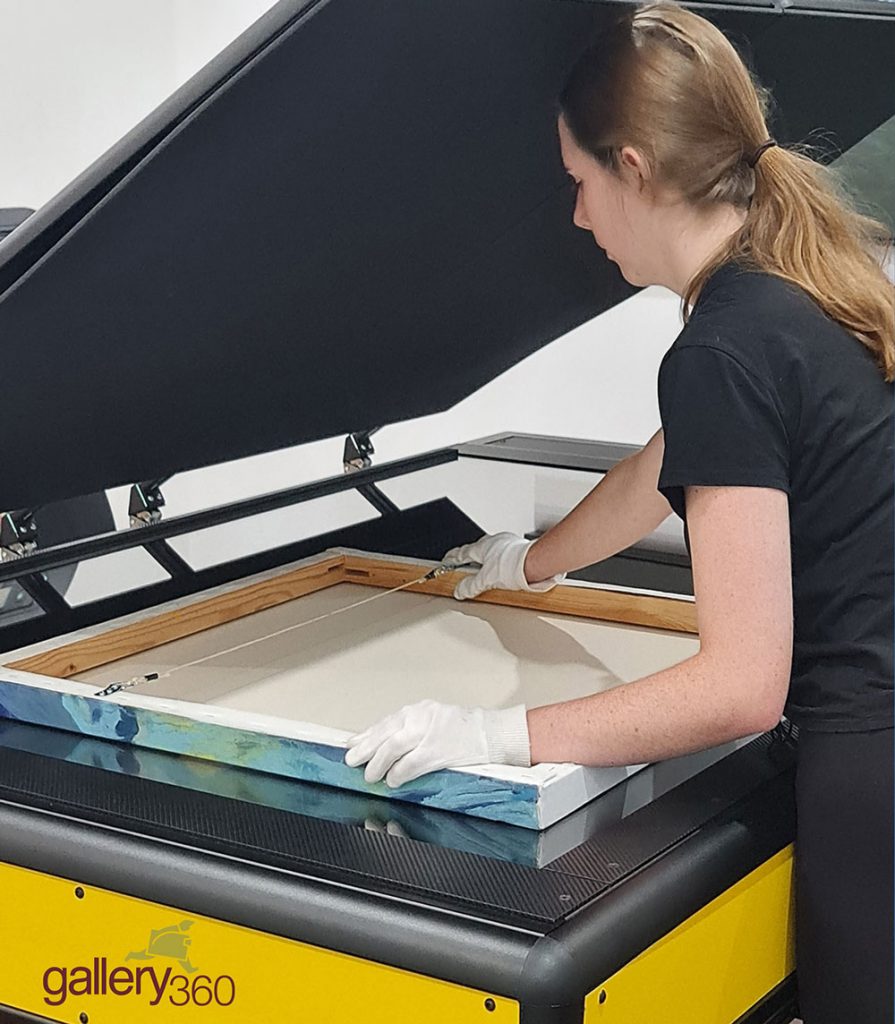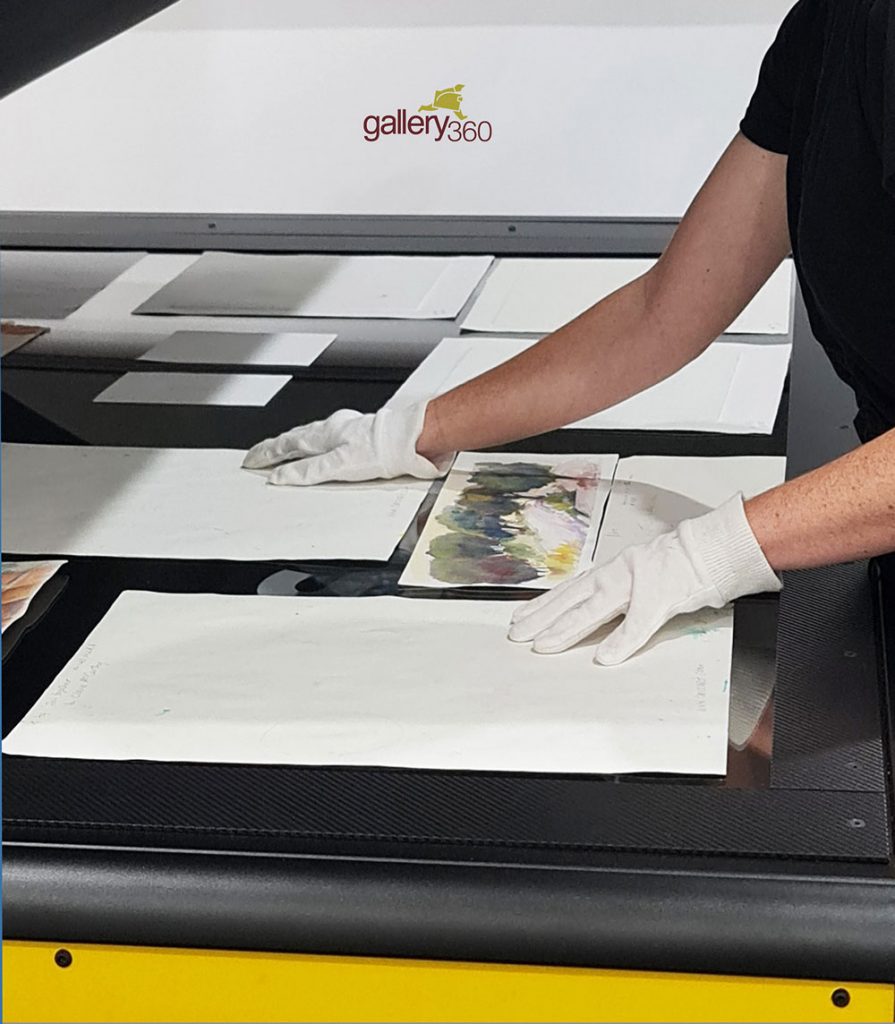Artwork Scanning
When it comes to artwork scanning, Gallery 360’s large format flatbed optical scanner lifts your digital reproductions to a new magnitude. Boasting German engineering and build quality, it is one of only three scanners of its kind in Australia. Our artwork scanner provides a 3D dimension to 3D artwork scanning for fine art paintings. Not even the most sophisticated 3D scanner can produce a print replica to the same standard as our optical scanner.
Large Format Scanner
Incorporating an enormous flatbed size of 1220mm X 1778mm, our scanner is specifically designed to capture and scan ultra-fine artwork and wallpaper detail by scanning up to an astounding 1200 full optical pixels per inch *. (*Based on suitable media).
This enables scanned paintings and other artworks to be tripled from its original size due to true optical resolution.
Our commercial scanner is equipped with a special LED light illuminator that does not produce any ultraviolet or infrared radiation, resulting in harmless and uniform illumination during the scan.
Our Artwork Scanner
Gallery 360’s artwork scanner achieves a very high geometrical accuracy which makes it ideal for usage in the GIS, cartography and land survey environment.
The scanner provides high quality images based on state-of-the-art Visual 3D technology to pick up textures and layers in both flat and dimensional artworks with reproductions that produce results that look like 3D.
It offers the capability of digitising structured surfaces such as wood, rubber, plastic, fabrics, carpet and many more types of material. Finally, light reflecting items such as coins, seals and metal prints can be captured at the highest quality.
Photo Scanning Services in Perth
Our commercial optical scanner technology allows us to scan multiple artworks and photos quickly and with stunning results. Whether you’re an artist looking to create prints of your original pieces, or you want to preserve some precious photos, our optical scanner can help you. Contact Gallery 360, to find out more about our photo scanning services today.
Scan Your Artwork with Gallery 360
Create high-quality artwork reproductions with our scanning service at Gallery 360. For more information about our artwork scanning process or to organise an artwork scan, get in touch with one of our friendly art experts today by calling (08) 9381 6577 today.


Artwork Scanning Frequently Asked Questions
Many artists think you must use cameras to capture digital images of your artwork to create digital files for reproducing prints.
However, the cost of getting professional studio photography, complete with the correct lighting set up and equipment and a skilled photographer is not cheap. The final resolution of the digital image will require time and skill doing colour corrections of the digital image to attempt to capture the colours on the original artwork. The completed digital file will show a 2D image and the shadows caused by texture in the artwork, will be flattened on the print. Due to the nature of camera lenses, some distortion of the image will result. The light on the artwork, will often be uneven in the final print.
Yes, when scanning artwork we use a flatbed scanner and, in some cases, we can scan the artwork under the glass inside the frame without taking out the artwork. But any dust or imperfections in the glass will appear in the scanner, so make sure it is cleaned first.
Yes. We get fabulous results and the texture from thick paint will show well on the final scanned image.
Artwork Reproduction: Flatbed Scanning vs Photography
Both scanning and taking photographs of original artwork creates a useful digital copy, which can be used to reproduce a fine art print. It is an important process for artists, to ensure they have a usable, comparable version of their artwork for online and print portfolios, and future print production. Digital copies of artwork come in handy for posters and pamphlets at galleries and museums. A digital image can also be altered in any way the artist or designer chooses, without damage to the original.
Using 3D Artwork Scanners
A flatbed 3D scanner is most often used to capture two-dimensional artwork. Some high-end flatbed scanners incorporate a 3D component to enable any texture and shadows to show up on the scan, to create a 3D illusion on the final print. This is excellent for artworks with thick paint, etc.
Artwork Reproductions Using Photography
Used to capture digital images of 2D and 3D artwork, these photographs are generally taken against a white or neutral background, with natural or studio lighting, to replicate the effect of a 3D artwork scanner. Shadows and reflections must be removed so the digital image is clear and uniform in colour.
| Summary | Scanner | Photography |
| Colour | Will match the original colour, if scanner is accurately colour calibrated. | Depending on lighting, colour may need to be altered in your image editing software. |
| Size of original | Up to 1220mm X 1778mm, and a depth (with or without frame) of 100mm. in one scan. Large Artworks or maps, can be done in sections and joined. | No limit, can be done in sections. Suitable for large artwork, or pieces that can not be laid on a scanner, such as murals. |
| Resolution | Will be relatively uniform for each same-size original on the same scanner. | Depends on the quality of the camera and lenses, the focus, and the distance from the original. |
| Lens Distortion | Only occurs if the image is not laid flat in the scanner. | Often occurs and difficult to avoid, but may be able to be improved in image editing software. |
| File DPI (PPI) | Can be set prior to scanning the image Up to 1200 PPI (DPI) full optical resolution. | Can be altered in an image editor, but this will shrink the print size (pictures generally taken at 72 DPI). |
| Print Size | Most prints scanned at 600 DPI or larger can be reproduced up to four times the size of the original. | Depends on the quality of the photograph, and the camera. A good quality image can be twice the size of the original. |
| Production Time | A quick set up and immediate result. Multiple takes are generally not required due to consistency. | The process takes longer, due to set up time, multiple takes and inspection of each digital image to ensure it is of acceptable quality. |
| Equipment Price | A professional scanner costs $100,000-$400,000. A smaller, high-quality scanner costs approximately $4,000. | A professional-quality Digital SLR camera and equipment (lens, lighting) costs between $15,000 and $90,000. |
| Service Price | A small image will cost approximately $30.00, but prices increase with size. For pricing, contact us to ask about our prices. | Professional photographing costs approximately $100.00 per piece, and up to as much again for editing/color matching. |
Colour
Capture Your Art’s True Colours with an Art Scan
When you order a scan from a professional scanning company, their scanner will be calibrated, and they can also colour match your original. Following this, you can request a proof, which is a small portion of your image, printed at full size, which enables you to view the result and allow the printer to calibrate colours further if necessary. Though all these post-scan options will result in a good quality image, it is best to have the original scanned on a well calibrated scanner, so the image is as close to the original as possible, without editing.
Editing in Colour with Photography
When photographing artwork, one of the most difficult tasks is to ensure the lighting is correct. The area must be bright enough to properly highlight the image, all its details and variations, but any direct light is going to cause shadows in other parts of the image. Natural or studio lighting is the easiest way to achieve this even lighting and should result in a digital image with the same colours as the original, as long as the camera’s white balance is properly set beforehand. However, nearly all photographed images will require editing to match the original.
Lens Distortion
Scanning
Lens distortion is minimal when scanning when the image is laid flat. The scanner will run along the entire bed of the machine, recording each part of the image from directly underneath. However, if the image to be is on a stiff base that is warped, some distortion may be unavoidable. Often, this can be fixed in an image editing software.
Photography
Lens distortion is more common when photographing images. From whichever angle the photograph is taken, sections of the image will be farther away, and others will be closer to the camera. This causes parts of the image will appear larger than others. To minimise this, it is best to take the photograph from overhead, ensuring that the camera is positioned in the very centre of the image and that space is left around the image to allow for any corner distortion. Using a zoom function minimizes distortion as well.
Digital reproductions: size, resolution and DPI (PPI)
Resolution
The higher the resolution of a digital image, the more detail it can display accurately. Digital images are created from a series of small square boxes of colours called pixels. Resolution is indicated by the number of pixels from which the image is created. For example, an image that is 3200×2600 pixels will be a higher resolution than one that is 320×260 pixels. While resolution does not guarantee that a photograph or scanned image is good quality, it does generally affect the maximum print size. Generally, the resolution will be pre-determined by the camera or the scanner, depending on brand and quality.
Size
The maximum possible print size is partially determined by the resolution, but there are many other factors that affect print size as well. At 300 DPI, most digital images can be printed the size of the original, or sometimes up to twice that size. A top professional quality art scanner can scan up to 1200DPI at full optical resolution.
When photographing artwork, the image size will vary based on the quality and focus of the camera and lens, the position and distance the camera was from the original.
Dots Per Inch (DPI)
Pretty much the same thing as Pixels Per Inch (PPI): For an ideal printed reproduction, the scanner can be programmed to scan the image at 300 or 600 DPI. This setting is determined by the type of printer that is used, as this will affect how many “dots” of ink the printer can spray in a one-inch area. Most quality inkjet printers print at 300 DPI or higher. Most Digital photographs are generally 72 DPI. Though the DPI can be changed to 300 or 600 with editing software, this will severely lower the maximum print size. The software is adding pixels to the image file and it has to interpolate (guess) the colour of these pixels based on the surrounding pixel colours, with varying results.
Be aware that many consumer scanners claim to capture at 1200+ pixels per inch – However, they use a method called “interpolation” where scanning software adds additional pixels into the final file. Not recommended because this does not provide true resolution and the finer details on the original are not accurate.